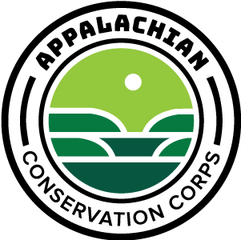Connecting Under-Represented Communities to their History at C&O Canal
Individual PlacementsJune 12th, 2024 | Williamsport, MD – Our National Parks exist to preserve both the natural and social history of our country, and it’s important for visitors to see their communities reflected in that history. One ACC member saw the proof of this at his park.
ACC Individual Placement Kristian Broche has spent the last year as an Interpretation IP at C&O Canal National Historical Park, orienting visitors to the Williamsport site. He created and delivered educational programming to visitors, including boat tours along the retired Canal that operated from 1831 until 1924 along the Potomac River. Kristian focused on sharing under-told stories about the Canal to broaden the park’s audience and connect folks with their community’s historical contributions.

ACC IP Kristian giving a program at C&O Canal’s Williamsport Visitor Center.
“As a first-generation Latino American, the child of immigrants from Honduras and Cuba, I understand firsthand the challenges newcomers can face in feeling a sense of belonging in a new place," Kristian said. "Often, immigrant communities struggle to see themselves reflected in historical and cultural narratives of their adopted home."
Kristian spearheaded bilingual projects, such as putting park signage in English and Spanish, giving boat tour programs in both languages, and creating NPS-themed “Loteria” games. Visitors have been grateful for the efforts, Kristian said. They have thanked and even hugged him after programs.
“It made me realize the power of using familiar cultural traditions to spark a connection,” he said.
Kristian said Latino visitors are more likely to open up during programs and ask questions to rangers like himself and his coworker who are part of the community. His biggest accomplishment in the last year was helping make park historical resources more accessible to marginalized communities, Kristian said.
His other projects at the park focused on women and African American communities that played integral roles in the Canal’s operation.
In a poster presentation, Kristian explored women’s crucial contributions to the Canal as lock keepers and captains. Being a historic site, many folks assume these duties were solely done by men, Kris said. However, not only were women working on the Canal, but they were also coal laborers and mill workers performing manual labor.

Kristian’s poster about Women on the C&O Canal.
Another presentation shared the intertwined history of African Americans, both free and enslaved, surrounding the Potomac River and C&O Canal. Many park visitors noted they were unaware their community helped manage the Canal, which shows the importance of connecting folks to these under-told stories, Kristian said.
“It was important for the program to include a list of full names of those to remember, delving into their birthplaces and jobs, noting the juxtaposition of the lives of free and enslaved African Americans during and after the Civil War,” Kristian said. “Also, including how integral the communities were in preserving and restoring the C&O Canal via the Civilian Conservation Corps.”

ACC IP Kristian posing with his poster on African American History at C&O Canal.
Aside from sharing the park’s social history, Kristian also led programs about the Canal’s ecology. Kristian earned his associate’s in biology from Hagerstown Community College before receiving his bachelor’s in ecology and environmental biology from Shippensburg University, and he hopes to pursue natural resources after his second internship with ACC and C&O Canal.
His passion for ecology started in childhood, with Steve Erwin as his biggest role model. In early high school, Kristian joined an Upward Bound program in Miami, where he surveyed wildlife in national parks throughout Florida, studying coral reefs, sharks, and other species.
Through his internship at the Canal, Kristian cross-trained with the park's natural resources department, where he helped conduct surveys of native and endangered bat species, assisted in prescribed fire assessments and helped identify rare plant species.
Kristian recently started a second term at Williamsport Park, where he will continue to craft educational programs for visitors into the fall. Once his term is over, Kristian will attend graduate school for Geographic Information Systems and then use the Public Lands Corps Hiring Authority he earned during his internship to get into a federal Natural Resource Department.
“My service year experience taught me the profound power of bridging divides through using language, cultural understanding, and creative outreach,” Kristian said. “The most rewarding aspect of the internship was the people. Everyone, from park rangers to volunteers and fellow interns, fostered a welcoming and inclusive environment.”

Poster presentation on wildflowers of the Canal.





